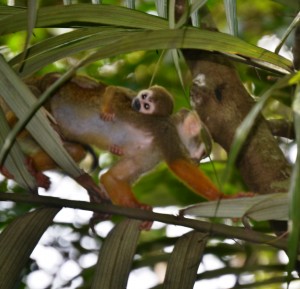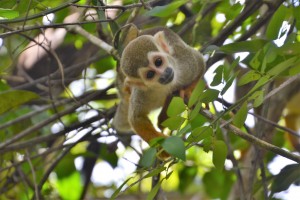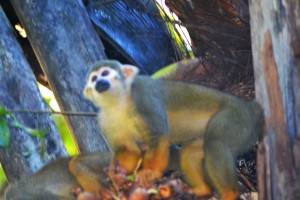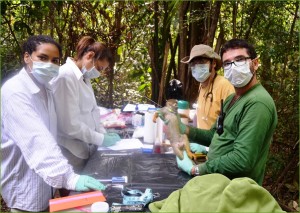Research
Primate behavioral ecology research in the Stone lab
Our research integrates perspectives from evolutionary biology, ecology and animal behavior in order to understand primate life histories and socioecology. We use long-term data on wild squirrel monkeys to address questions of social evolution, life history patterns and sexual selection, among others. To address these complex behavioral questions, we use a variety of approaches, such as field experiments, hypothesis-testing using observations in natural habitats, and molecular genetic analyses s. The diversity of methods and topics covered in this research allows me to advise students with a wide variety of interests.
Examples of current research topics
1. Reproductive ecology
Squirrel monkeys are seasonal breeders  and have very slow life histories. In addition, females show a heavy investment in offspring because of large neonatal brain size. We aim to understand how the seasonality of food availability in the forest, the monkeys’ reproductive seasonality and feeding behaviors are interrelated.
and have very slow life histories. In addition, females show a heavy investment in offspring because of large neonatal brain size. We aim to understand how the seasonality of food availability in the forest, the monkeys’ reproductive seasonality and feeding behaviors are interrelated.
2. The “fattened male phenomenon” (New NSF-funded project!)
A long-term projects examines sexual selection and reproductive strategies of squirrel monkey adult males. Why adult males? Because among primates, squirrel monkey males have a unique reproductive physiology, experiencing seasonal enlargement during the 2-month mating season. Quite literally, males “poof up” in order to breed (think football players in padded uniforms). Although all species of squirrel monkey show this fattening response, we still do not know the evolutionary function of this phenomenon. Why fatten? Do fatter males have some sort of mating advantage? And do they ultimately father more offspring? If so, is it by intimidation of other male rivals? Or, may the fattest males appear more attractive to females who then prefer to mate with them? This 5-year project integrates behavioral observations with genetic data (with our collaborators at UCLA and UTA), to determine whether the fattest males have higher access to females and if these males are of higher genetic quality.
3. Intragroup social structure
Squirrel monkeys live in very large social groups: 40 to 50 individuals! However, we know very little about the structure of these groups. Are individuals in a social group closely related and do they form kin-based networks? Are there dominance hierarchies among the females, and among the males? Which sex disperses from their natal group and how far do they go? Together with colleagues in Brazil, I have initiated a capture and monitoring program of several groups of monkeys at my study site. Marking animals for individual identification and collection of biological samples give us powerful tools to investigate patterns of kinship and dispersal in the species.

4. Social bonds and social behaviors within groups
For a primate that lives in large social groups, squirrel monkeys are not what we call very “social”. For example, they do not engage in grooming, and this is true even of mother-infant pairs. In fact, physical contact is rare, except in the case of mating behaviors and juvenile play. So how do squirrel monkeys maintain their social bonds? One possibility is that squirrel monkeys “vocally groom” each other, through their wide array of frequent calls, and that helps them stay connected (like texting your friends when you can’t see them). And, in a group of 50 animals, who do they choose to form bonds with? Their relatives? Their age peers? Molecular data on kinship and behavioral data on association patterns of marked individuals can help us answer such questions.
Collaborations
Mathematics Department, Cal Lutheran: We often work with Dr. Chris Brown, statistician extraordinaire, who helps us make sense of our monkey data. Especially when it comes to using R for analyses.
UCLA Institute for Society and Genetics: We are working with Dr. Jessica Lynch to conduct molecular and kinship analyses on our wild squirrel monkeys.
University of Texas Arlington: We also are working with Dr. Janet Buckner to examine the diversity and quality of MHC genes in male squirrel monkeys.

